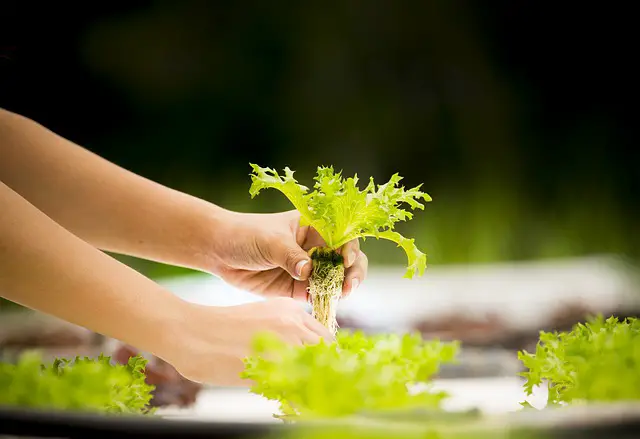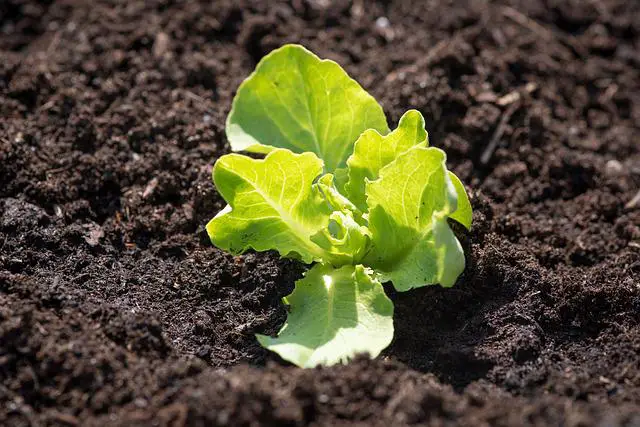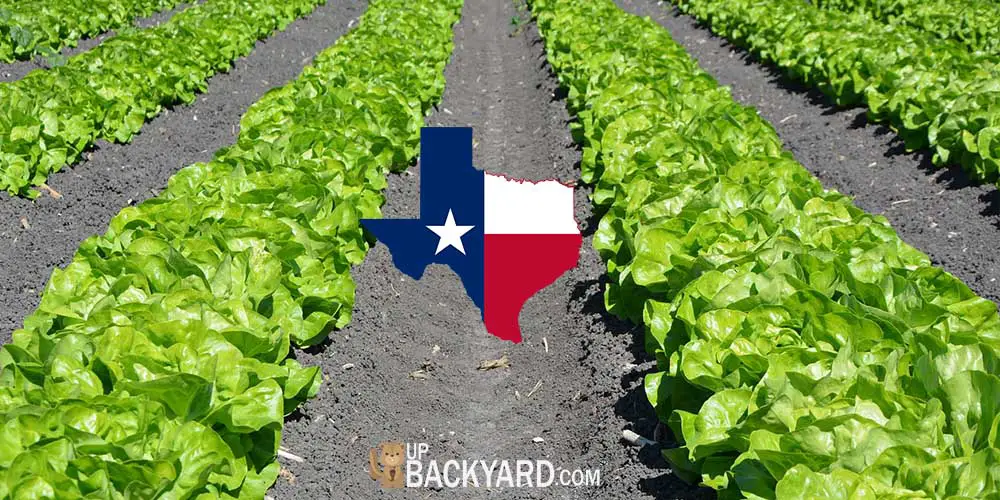Lettuce is a tough annual – it can withstand a wide range of temperatures. However, that doesn’t mean that you can plant it any time in Texas.
There is still an ideal temperature range for lettuce to thrive in the Lone Star State. If you plant it outside of this ideal range, you may be in for some disappointment.
Fear, not fair gardeners – this article is the perfect guide to planting lettuce in Texas at the perfect time.
The tips you’ll find here are practical, easy to implement, and will help you yield the best crop. After all, everything in Texas is better and that should include your lettuce.
Let’s dig in!
When is The Perfect Time to Plant Lettuce in Texas?

In general, Texas is a great place for growing plants. In fact, that’s why around 86% of the land in Texas is used for agriculture purposes.
The weather is suitable almost year-round, the state gets plenty of rain, and there is plenty of nutrient-dense soil in Texas.
The temperatures in Texas can vary depending on what part of the state you’re planting in, so it’s hard to get an average temperature during a certain time of year.
Snow is rare and it mainly occurs in the northwest part of the state where temperatures are more likely to be below freezing.
The rest of the state tends to enjoy mild to hot weather most of the year with winters rarely dipping below the low forties.
On the other hand, Texas can get very hot and humid. In fact, when most people think of Texas, they imagine the Lone Star State with scorching heat shining down on expansive farms and landscapes.
The further south you are in the state, the hotter it gets (which is true of the entire United States), but luckily the heat is blazing only a few months of the year.
Between the sporadic freezing temperatures and the few months of unforgiving heat, you have a large chunk of the year that is suitable for growing lettuce.
This is great news! This means it’s hard to go wrong when growing lettuce in Texas.
However, planting it at the ideal time will ensure the best success and the most bountiful yield possible. You don’t necessarily need to avoid the extreme weather months, you just have to work around them.
Lettuce can be planted from seeds or transplanted. They germinate well in cool to moderate temperatures. The ideal soil temperature for germination is 75°F. Lettuce seeds are able to germinate in lower temperatures, but the colder it is, the longer they will take to germinate.
Based on the above information, the best time to plant lettuce is from September through March, during cooler weather. The ideal months in this range are October through November. Planting them early will give the seeds a chance to germinate before any possible frosts. As stated before, the location in Texas is important so you can adjust the ideal months to match your area.
Why Is It Important To Plant Lettuce At The Right Time in Texas?
Lettuce is a half-hardy annual meaning that it has the ability to withstand some freezing temperatures, but not as well as a hardy annual. Since Texas has a short period of freezing temperatures, it’s perfectly suited for half-hardy annuals.
The reason that you need to plant lettuce at the right time in Texas is because the germination process can be delicate. Germination can be affected by so many things, especially the temperature. You should give seeds their best fighting chance to survive.
For starters, planting your seeds in weather that is too cold can deprive seeds of oxygen. Seeds simply can’t breathe through a frozen ground.
In fact, there isn’t anything that can breathe through frozen ground! Seeds can make it for a little while in freezing temperatures – they have the ability to absorb and store what they need for a short period of time.
However, once this time is up, if they’re still in frozen ground, they won’t germinate well or possibly not at all.
On the other hand, planting seeds in weather that is too hot can result in the seeds drying out. Extreme heat can cause the moisture in soil to evaporate, leaving your seeds with no water.
Without water, seeds can’t absorb nutrients from the soil. They dry out and will eventually die.
You also need to watch out for heavy periods of rain. Too much watering can cause a number of issues.
For one, too much water can encourage unhealthy fungi to grow and consume your seeds. Another issue is that the soil can become too compacted and seedlings can’t break through. A third issue is that, with continuous over-watering, seeds will simply drown.
Weather can be quite unpredictable and there is no way that you can control the weather.
However, planting your lettuce at ideal times of the year will reduce your risk of running into the aforementioned problems. You know what they say – if you do it right the first time, you won’t have to do it again.
Tips and Reminders For Planting Lettuce in Texas
Lettuce is a strong and resilient vegetable. It can germinate and grow in a wide variety of temperatures although growth may be stunted outside of ideal planting times.
Here are a few more tips that will help you grow your lettuce successfully.
Tip #1 – Keep Your Lettuce Cool

Keep in mind that lettuce thrives in cool weather. This means that you should plan to plant your seeds early enough so that your seedlings are sprouting as the weather cools down.
If your lettuce happens to be growing during extremely hot temperatures, you can protect it with a cover. This will keep the leaves from getting bitter, which leads to the next tip.
Tip #2 – No One Likes Bitter Lettuce
When lettuce gets the signal that it’s matured, it bolts. This means that it sends up flower shoots that make the leaves bitter.
It can also make the leaves shorter and tougher. Essentially, it makes the lettuce inevitable.
There are quite a few ways to prevent the lettuce from bolting. One of the main ways is something that we’ve been discussing all along – keep the lettuce from getting too hot. Overheating triggers a bolting signal in the lettuce, especially if the lettuce gets dried out.
Another simple way, especially for beginners, is to buy lettuce seeds that are especially created to resist bolting.
These seeds will have some type of indication of this. They may be labeled as “slow to bolt” or have a snappy name like “Slobolt Seeds“.
Note that although these seeds slow bolting, they don’t stop them all together. You’ll still need to take steps to prevent bolting.
One other tip to prevent bolting is to continuously trim lettuce leaves. This prevents the plant from triggering the maturity signal which ultimately prevents bolting.
You may also end up with more lettuce than you bargained for from your plants because the lettuce will continue to grow as you trim the leaves.
Tip #3 – Make Sure The Soil Is Right.
Lettuce seeds are small and they don’t need to be buried too deeply. If you bury them too deeply, it could cut off their oxygen supply.
You should bury them no deeper than 1/2 inch deep. Make sure the soil is loose and cool.
You should space your lettuce seeds anywhere from 12 to 18 inches apart. Once they become seedlings, thin them down to between 6 to 8 inches apart.
Having plenty of space allows them to spread as much as possible giving you a good yield.
Tip #4 – Pest Control
Another big concern with your soil is pest control. You can’t do much to keep pests out, so you’ll need to try to attract beneficial insects.
These insects will get rid of the harmful insects by eating them. You can also attempt to attract toads and certain types of birds. They do a great job of eating bugs.
After they eat all the bugs, you’ll need to keep them around when the unwanted pests come back.
Try allowing a few of your lettuce plants to bolt and birds will happily feast on the flowers from these plants. You could also keep water sources handy for birds and toads.
Final Thoughts
Lettuce is one of the best veggies you can grow in Texas. After all, who doesn’t love fresh, crisp lettuce for a salad or on a juicy burger?
Plus, it’s a great vegetable for gardeners of all skill levels since it’s pretty easy to keep growing.
Whether you have a home garden, a commercial farm, or something in between, following the steps above can help your lettuce-growing endeavors be a major success.
Just plant the lettuce seeds during the ideal time frame, keep the lettuce cool, prevent bolting, and keep the pests at bay. Simple!
